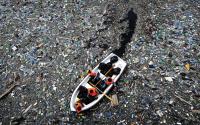by Michael McCarthyThe map of Greenland will have to be redrawn. A new island has appeared off its coast, suddenly separated from the mainland by the melting of Greenland's enormous ice sheet, a development that is being seen as the most alarming sign of global warming.
Several miles long, the island was once thought to be the tip of a peninsula halfway up Greenland's remote east coast but a glacier joining it to the mainland has melted away completely, leaving it surrounded by sea.
Shaped like a three-fingered hand some 400 miles north of the Arctic Circle, it has been discovered by a veteran American explorer and Greenland expert, Dennis Schmitt, who has named it Warming Island (Or Uunartoq Qeqertoq in Inuit, the Eskimo language, that he speaks fluently).
The US Geological Survey has confirmed its existence with satellite photos, that show it as an integral part of the Greenland coast in 1985, but linked by only a small ice bridge in 2002, and completely separate by the summer of 2005. It is now a striking island of high peaks and rugged rocky slopes plunging steeply to a sea dotted with icebergs.
As the satellite pictures and the main photo which we publish today make clear, Warming Island has been created by a quite undeniable, rapid and enormous physical transformation and is likely to be seen around the world as a potent symbol of the coming effects of climate change.
But it is only one more example of the disintegration of the Greenland Ice Sheet, that scientists have begun to realise, only very recently, is proceeding far more rapidly than anyone thought.
The second-largest ice sheet in the world (after Antarctica), if its entire 2.5 million cubic kilometres of ice were to melt, it would lead to a global sea level rise of 7.2 metres, or more than 23 feet.
That would inundate most of the world's coastal cities, including London, swamp vast areas of heavily-populated low-lying land in countries such as Bangladesh, and remove several island countries such as the Maldives from the face of the Earth. However, even a rise one tenth as great would have devastating consequences.
Sea level rise is already accelerating. Sea levels are going up around the world by about 3.1mm per year - the average for the period 1993-2003. That is itself sharply up from an average of 1.8mm per year over the longer period 1961-2003. Greenland ice now accounts for about 0.5 millimetre of the total. (Much of the rest of the rise is coming from the expansion of the world's sea water as it warms.)
Until two or three years ago, it was thought that the break-up of the ice sheet might take 1,000 years or more but a series of studies and alarming observations since 2004 have shown the disintegration is accelerating and, as a consequence, sea level rise may be much quicker than anticipated.
Earlier computer models, researchers believe, failed to capture properly the way the ice sheet would respond to major warming (over the past 20 years, Greenland's air temperature has risen by 3C). The 2001 report of the UN's Intergovernmental Panel on Climate Change was relatively reassuring, suggesting change would be slow.
But satellite measurements of Greenland's entire land mass show that the speed at which its glaciers are moving to the sea has increased significantly in the past decade, with some of them moving three times faster than in the mid-1990s.
Scientists estimate that, in 1996, glaciers deposited about 50 cubic km of ice into the sea. In 2005, it had risen to 150 cubic km of ice.
A study last year by the Jet Propulsion Laboratory of the California Institute of Technology showed that, rather than just melting relatively slowly, the ice sheet is showing all the signs of a mechanical break-up as glaciers slip ever faster into the ocean, aided by the "lubricant" of meltwater forming at their base. As the meltwater seeps down it lubricates the bases of the "outlet" glaciers of the ice sheet, causing them to slip down surrounding valleys towards the sea,
Another discovery has been the increase in "glacial earthquakes" caused by the sudden movement of enormous blocks of ice within the ice sheet. The annual number of them recorded in Greenland between 1993 and 2002 was between six and 15. In 2003, seismologists recorded 20 glacial earthquakes. In 2004, they monitored 24 and for the first 10 months of 2005 they recorded 32. The seismologists also found the glacial earthquakes occurred mainly during the summer months, indicating the movements were indeed associated with rapidly melting ice - normal "tectonic" earthquakes show no such seasonality. Of the 136 glacial quakes analysed in a report published last year, more than a third occurred during July and August.
The creation of Warming Island appears to be entirely consistent with the disintegrating ice sheet, coming about when the glacier bridge linking it to the mainland simply disappeared. It was discovered by Mr Schmitt, a 60-year-old explorer from Berkeley, California, who has known Greenland for 40 years, during a trip he led up the remote coastline.
According to the US Geological Survey: "More islands like this may be discovered if the Greenland Ice Sheet continues to disappear."
A self-governing dependency of Denmark, Greenland is the largest island in the world but is inhabited by only 56,000 people, mainly Inuit. More than 80 per cent of the land surface is covered by the ice sheet.






